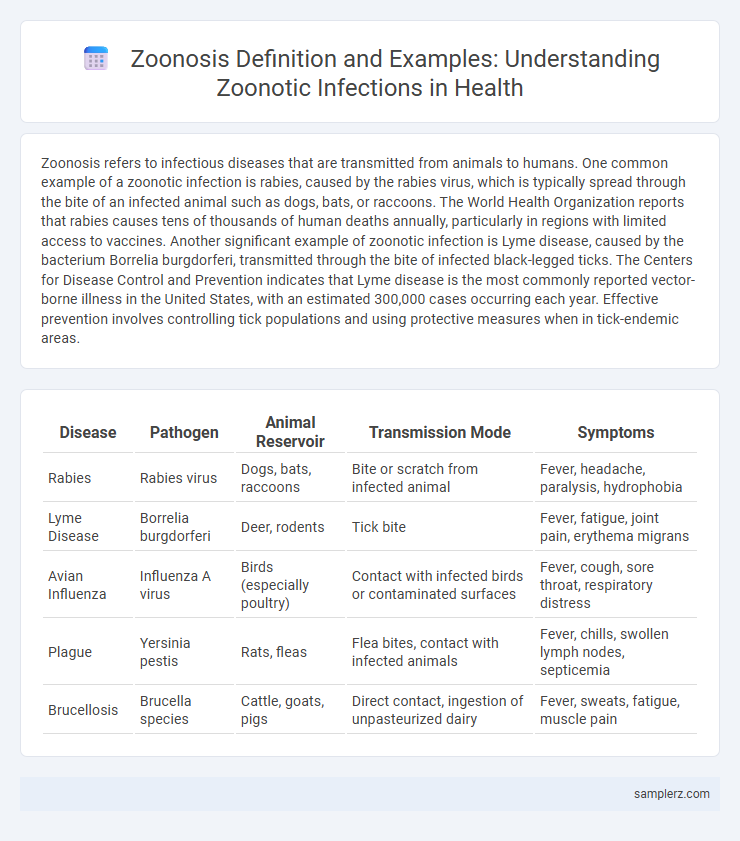Zoonosis refers to infectious diseases that are transmitted from animals to humans. One common example of a zoonotic infection is rabies, caused by the rabies virus, which is typically spread through the bite of an infected animal such as dogs, bats, or raccoons. The World Health Organization reports that rabies causes tens of thousands of human deaths annually, particularly in regions with limited access to vaccines. Another significant example of zoonotic infection is Lyme disease, caused by the bacterium Borrelia burgdorferi, transmitted through the bite of infected black-legged ticks. The Centers for Disease Control and Prevention indicates that Lyme disease is the most commonly reported vector-borne illness in the United States, with an estimated 300,000 cases occurring each year. Effective prevention involves controlling tick populations and using protective measures when in tick-endemic areas.
Table of Comparison
| Disease | Pathogen | Animal Reservoir | Transmission Mode | Symptoms |
|---|---|---|---|---|
| Rabies | Rabies virus | Dogs, bats, raccoons | Bite or scratch from infected animal | Fever, headache, paralysis, hydrophobia |
| Lyme Disease | Borrelia burgdorferi | Deer, rodents | Tick bite | Fever, fatigue, joint pain, erythema migrans |
| Avian Influenza | Influenza A virus | Birds (especially poultry) | Contact with infected birds or contaminated surfaces | Fever, cough, sore throat, respiratory distress |
| Plague | Yersinia pestis | Rats, fleas | Flea bites, contact with infected animals | Fever, chills, swollen lymph nodes, septicemia |
| Brucellosis | Brucella species | Cattle, goats, pigs | Direct contact, ingestion of unpasteurized dairy | Fever, sweats, fatigue, muscle pain |
Common Zoonotic Diseases Transmitted to Humans
Rabies is a common zoonotic disease transmitted to humans through bites from infected animals such as dogs and bats. Another significant example is Lyme disease, caused by Borrelia burgdorferi bacteria and spread via black-legged ticks. Salmonellosis, resulting from Salmonella bacteria, is often contracted through contact with contaminated reptiles or poultry.
Viral Zoonoses: Key Examples and Impact
Rabies, Ebola virus disease, and Hantavirus pulmonary syndrome represent critical examples of viral zoonoses with significant public health impact. These infections originate from animal reservoirs, such as bats, rodents, and carnivores, transmitting viruses that cause severe morbidity and mortality in humans. Understanding the transmission dynamics and reservoirs of viral zoonoses is essential for developing effective prevention and control strategies to mitigate outbreaks.
Bacterial Zoonoses in Everyday Life
Bacterial zoonoses such as Salmonella and Campylobacter frequently contaminate undercooked poultry, posing significant infection risks in daily food handling. Contact with infected pets carrying bacteria like Bartonella henselae, responsible for cat scratch disease, represents another common transmission route in everyday environments. Proper hygiene and food safety measures are essential to reduce the incidence of these bacterial zoonotic infections.
Parasitic Zoonoses and Human Infection
Parasitic zoonoses such as toxoplasmosis and echinococcosis represent significant health concerns due to their transmission from animals to humans. Toxoplasmosis, caused by the protozoan Toxoplasma gondii, commonly infects humans through contact with contaminated cat feces or undercooked meat, leading to serious complications in immunocompromised individuals and pregnant women. Echinococcosis, resulting from Echinococcus tapeworm infections, causes cyst formation in vital organs, requiring early diagnosis and treatment to prevent severe morbidity.
Fungal Zoonotic Infections: Cases and Risks
Fungal zoonotic infections, such as sporotrichosis transmitted from cats to humans, present significant health risks due to their potential to cause severe skin infections. Cryptococcus gattii, commonly found in soil and on trees, can infect both animals and humans, leading to respiratory and neurological symptoms. Understanding these cases highlights the importance of monitoring animal reservoirs and environments to prevent fungal zoonotic transmissions.
Zoonosis Outbreaks: Historic and Recent Examples
Zoonosis outbreaks, such as the 1918 H1N1 influenza pandemic originating from birds and the 2003 SARS outbreak linked to civet cats, highlight the significant impact of animal-to-human disease transmission. Recent examples include the 2014-2016 West African Ebola epidemic caused by fruit bats and the ongoing COVID-19 pandemic, believed to have originated from a wildlife market. Understanding these historic and recent outbreaks underscores the critical importance of monitoring zoonotic pathogens to prevent future public health crises.
Animal Reservoirs in Zoonotic Disease Transmission
Rabies is a prime example of zoonosis where animal reservoirs like bats, raccoons, and dogs play a critical role in disease transmission to humans. These animal hosts harbor the rabies virus, enabling its spread through bites or saliva contact. Understanding animal reservoirs is essential for controlling and preventing zoonotic infections in public health.
Routes of Transmission for Zoonotic Infections
Zoonotic infections like rabies, Lyme disease, and salmonellosis primarily transmit through direct contact with infected animals, vector bites, and ingestion of contaminated food or water. Rabies spreads via bites from infected mammals, while Lyme disease is transmitted through tick bites carrying Borrelia bacteria. Salmonellosis commonly occurs by consuming undercooked poultry or eggs contaminated with Salmonella bacteria, highlighting diverse transmission pathways in zoonotic illnesses.
Prevention and Control of Zoonotic Diseases
Effective prevention and control of zoonotic diseases such as rabies, avian influenza, and Lyme disease involve coordinated efforts in surveillance, vaccination, and public education. Implementing strict biosecurity measures in livestock farms, promoting routine animal vaccinations, and improving sanitation can significantly reduce pathogen transmission from animals to humans. Early detection through integrated One Health approaches and collaboration between veterinary and human health sectors are crucial for mitigating outbreaks and protecting public health.
Future Threats: Emerging Zoonoses in Global Health
Emerging zoonoses such as Nipah virus and novel coronaviruses represent significant future threats in global health due to their potential for rapid cross-species transmission and high mortality rates. Climate change, urbanization, and increased wildlife-human interactions are driving factors accelerating the emergence of these infectious diseases. Strengthening surveillance systems and promoting One Health approaches are critical to preventing and mitigating outbreaks of zoonotic infections worldwide.

example of zoonosis in infection Infographic
 samplerz.com
samplerz.com